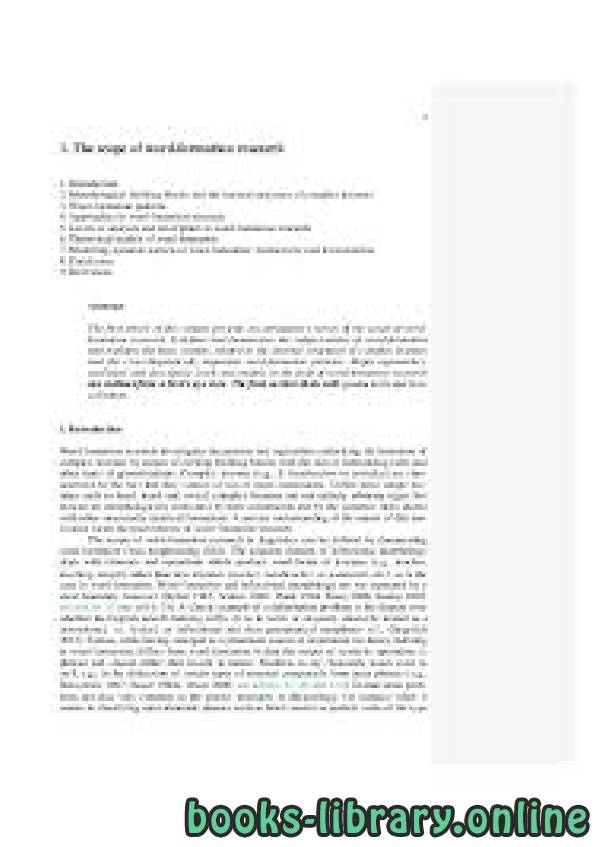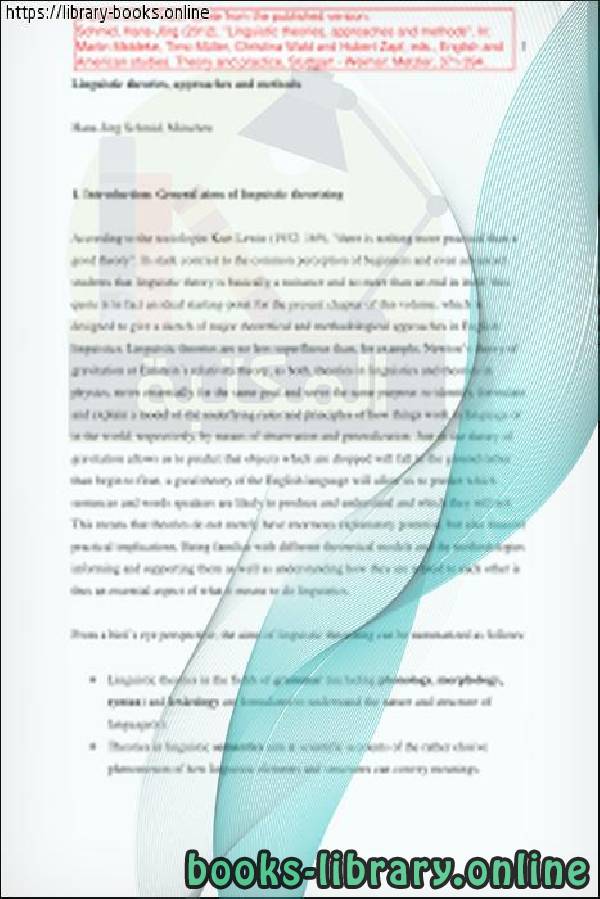📘 ❞ Chapter 4: Morphology Hans-Jörg Schmid ❝ كتاب ــ Hans-Jörg Schmid اصدار 2015
الصرف Morphology - 📖 ❞ كتاب Chapter 4: Morphology Hans-Jörg Schmid ❝ ــ Hans-Jörg Schmid 📖
█ _ Hans Jörg Schmid 2015 حصريا كتاب Chapter 4: Morphology 2024 Schmid: DRAFT VERSION! Quote the published version which includes extra material: Schmid, (2015), "Morphology" In: Natalie Braber, Louise Cummings and Liz Morrish, eds , Exploring Language Linguistics, Cambridge: Cambridge University Press, 77 110 Chapter Schmid Abstract Preview: In this chapter you will first learn to segment words into their smallest meaningful parts, morphemes Different types of then be distinguished on a number dimensions The classes arising from such distinctions are useful because they allow us formulate generalizations about properties shared by members these restrictions subject A second type generalization covered in concerns patterns rules underlie formation complex lexemes, i e that made up more than two lexical This is realm word You introduced range can used form new with help existing morphemes, including compounding, joining or lexeme (e g interest rate, washing machine watertight), prefixation, yielding as disagree, unjust ex minister, suffixation agreement, justify, ministerial) Further patterns, less regular transparent, include conversion (hammer N hammer V empty Adj V), back sightsee sightseeing; burgle burglar), blending infotainment information + entertainment), clipping ad advertisement, phone telephone), acronyms initialisms fixed sequences (URL unique resource locator; NATO North Atlantic Treaty Organization) 4 1 Introduction Generally speaking, linguistic discipline morphology – term derived Greek morphos meaning " examines internal makeup structure well principles underlying composition doing so, straddles traditional boundary between grammar (i rule based, productive component language) lexicon idiosyncratic, rote learned component) looks at both sides signs, meaning, combining perspectives order analyse describe parts الصرف مجاناً PDF اونلاين هذا القسم يحتوي علي كل ما يخص بعلم الصرف يتوفر علم تبيان تأليف الكلمة المفردة بتبيان وزنها وعدد حروفها حركاتها ترتيبها يعرض لذلك من تغيير وحذف وما ترتيبهما حروف اصالة زيادة يقتصر مجال دراسات الأسماء المتمكنة (المعربة) الافعال المتصرفة (غير جامدة) أما الحروف مبنيات جوامد فلا تدخل دراسته أبحاثه يُعرَفُ أيضا التشكل (باللاتينية: Morphologia) والصرف لُغَةً هو التغير والتحويل ومنه تصريف الرياح أي وجهتها مكان لآخر In linguistics, ( mɔːrˈfɒlədʒi ) study words, how formed, relationship other same language It analyzes stems, root prefixes, suffixes also speech, intonation stress, ways context change word's pronunciation differs morphological typology, classification languages based use lexicology, make language's vocabulary ]
DRAFT VERSION! Quote the published version which includes extra material: Schmid, Hans-Jörg (2015), "Morphology". In: Natalie Braber, Louise Cummings and Liz Morrish, eds., Exploring Language and Linguistics, Cambridge: Cambridge University Press, 77-110.
Chapter 4: Morphology Hans-Jörg Schmid
Abstract
Preview: In this chapter you will first learn to segment words into their smallest meaningful parts, their morphemes. Different types of morphemes will then be distinguished on a number of dimensions. The classes arising from such distinctions are useful because they allow us to formulate generalizations about the properties shared by the members of these classes and the restrictions they are subject to. A second type of generalization covered in this chapter concerns the patterns and rules which underlie the formation of complex lexemes, i.e. words that are made up of more than two lexical morphemes. This is the realm of word-formation. You will be introduced to the range of word-formation patterns that can be used to form new words with the help of existing words and morphemes, including compounding, i.e. the joining of two or more words to form a new complex lexeme (e.g. interest rate, washing-machine or watertight), prefixation, yielding words such as disagree, unjust or ex-minister, and suffixation (e.g. agreement, justify, ministerial). Further word-formation patterns, which are less regular and transparent, include conversion (hammer N to hammer V or empty Adj to empty V), back-formation (e.g. to sightsee sightseeing; to burgle burglar), blending (e.g. infotainment information + entertainment), clipping (e.g. ad advertisement, phone telephone), and the formation of acronyms or initialisms from fixed sequences of words (URL unique resource locator; NATO North Atlantic Treaty Organization). 4.1 Introduction Generally speaking, the linguistic discipline of morphology – the term is derived from the Greek word morphos meaning " form " – examines the internal makeup and structure of words as well as the patterns and principles underlying their composition. In doing so, morphology straddles the traditional boundary between grammar (i.e. the rule-based, productive component of a language) and the lexicon (i.e. the idiosyncratic, rote-learned component). Morphology looks at both sides of linguistic signs, i.e. at the form and the meaning, combining the two perspectives in order to analyse and describe both the component parts of words and the principles underlying the composition of words.
#2K
0 مشاهدة هذا اليوم#59K
6 مشاهدة هذا الشهر#59K
5K إجمالي المشاهدات
-
🎁 كن أول كاتب اقتباس في هذه الصفحة واحصل على هديّة 15 من النقاط فوراً 🎁



